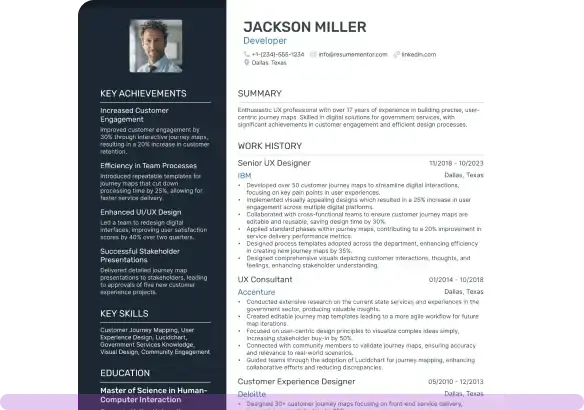Artist Resume Examples
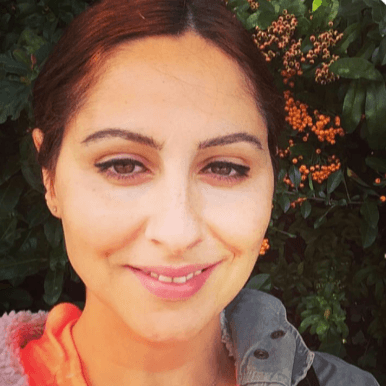
Mar 31, 2025
|
12 min read
Craft a standout artist resume with brushstroke finesse. This guide helps you paint a clear picture for future employers, highlighting your work while ensuring your creativity doesn't get lost in translation. Perfect your craft and draw attention.
Rated by 348 people
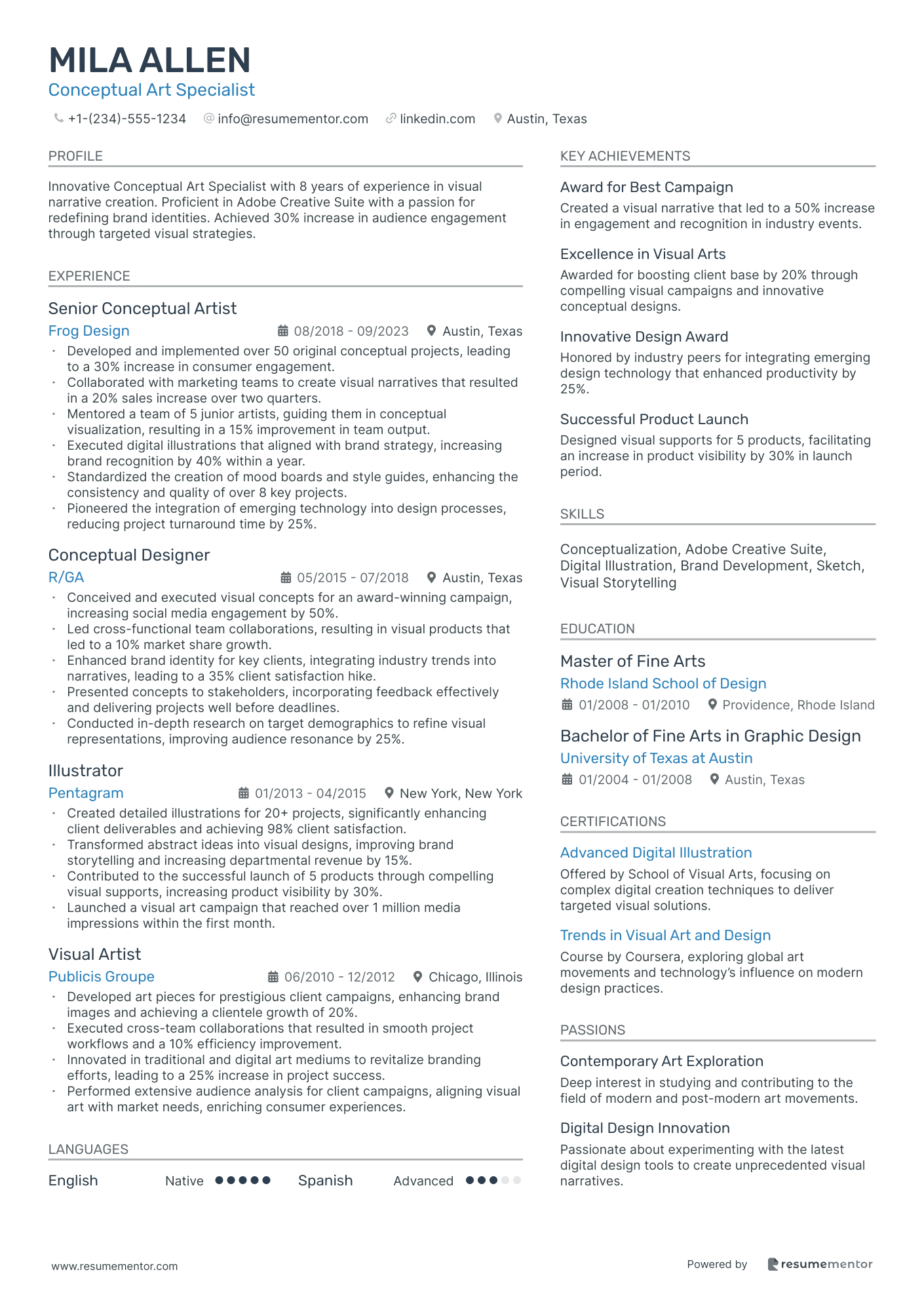
Conceptual Art Specialist
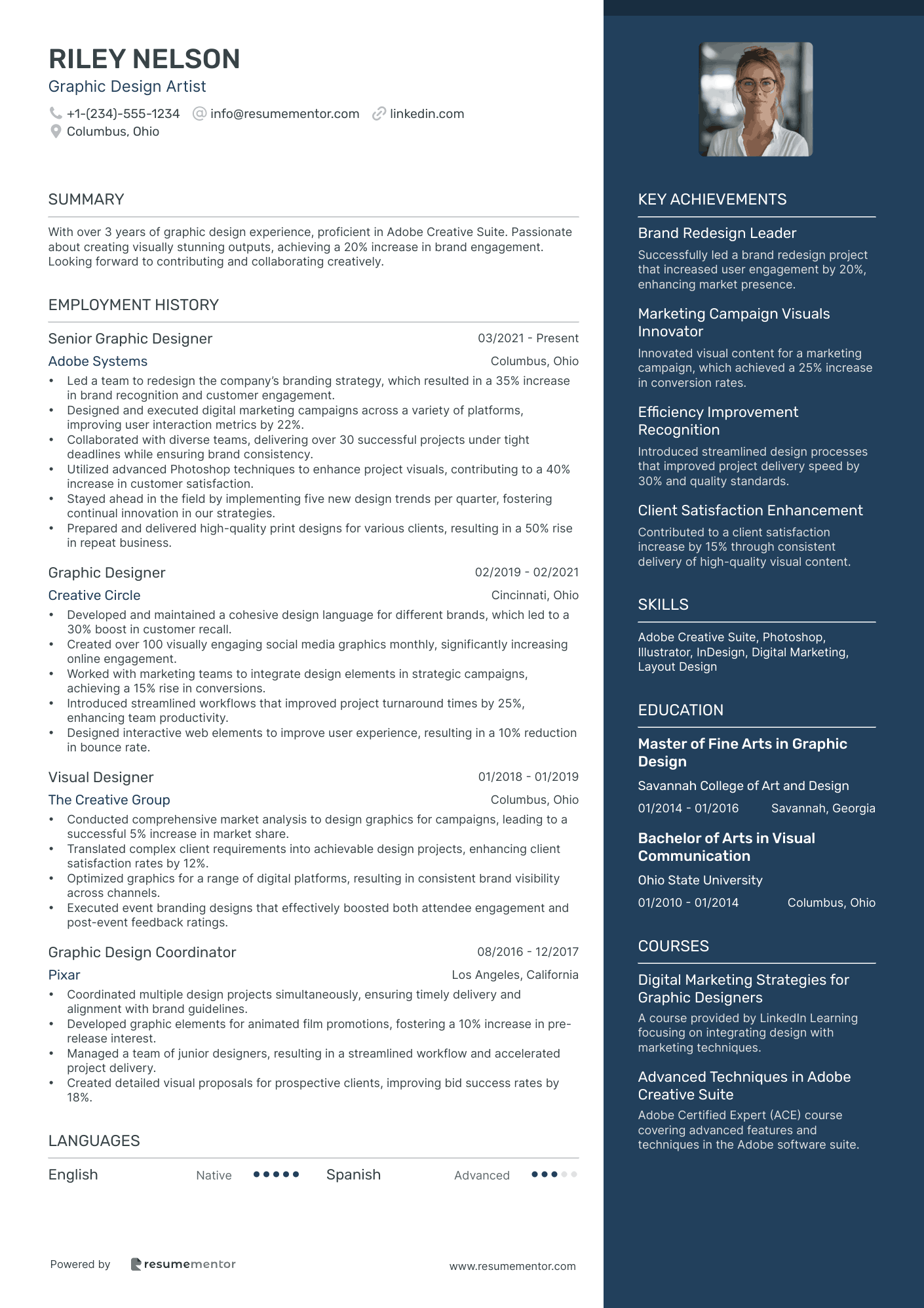
Graphic Design Artist
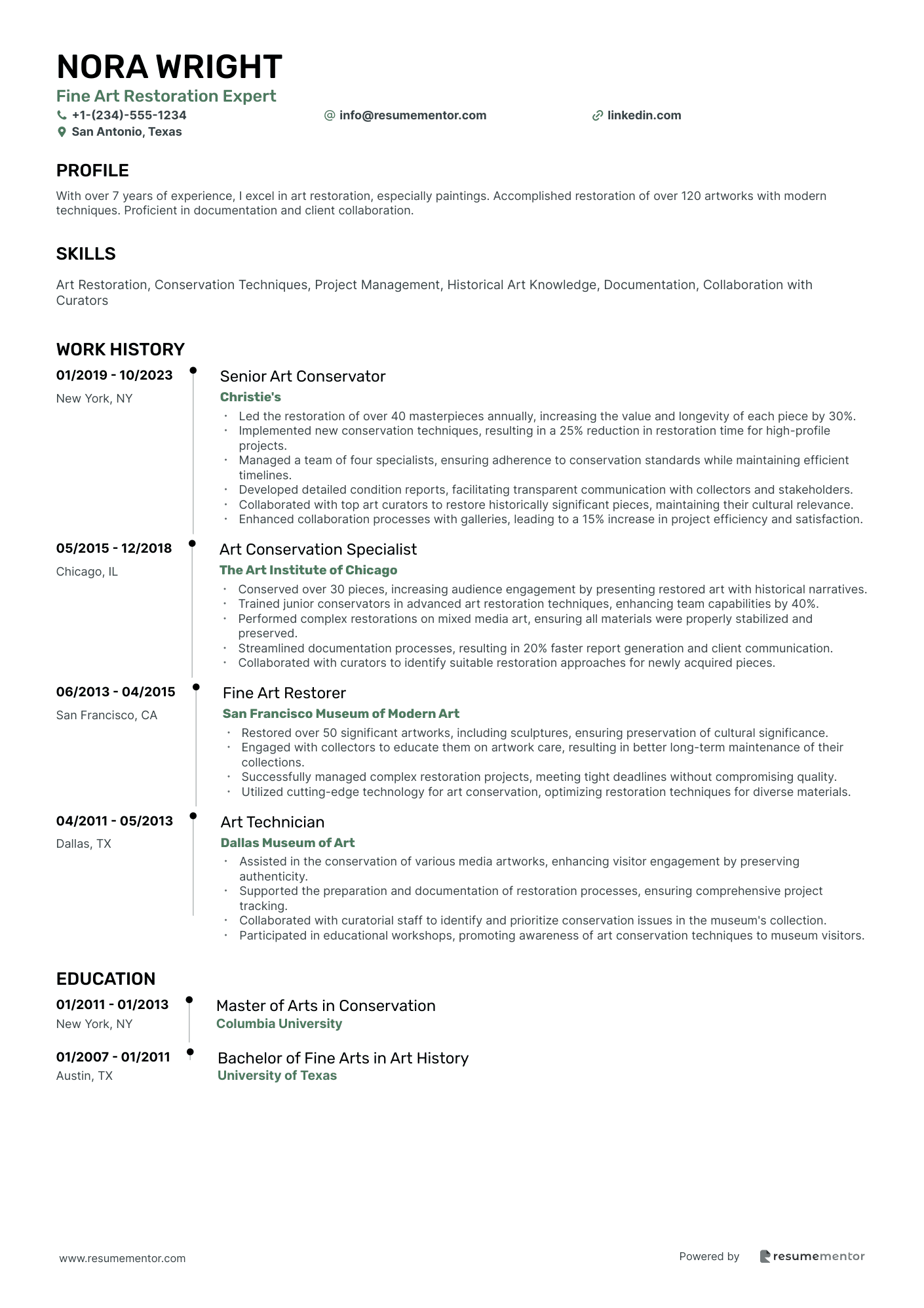
Fine Art Restoration Expert
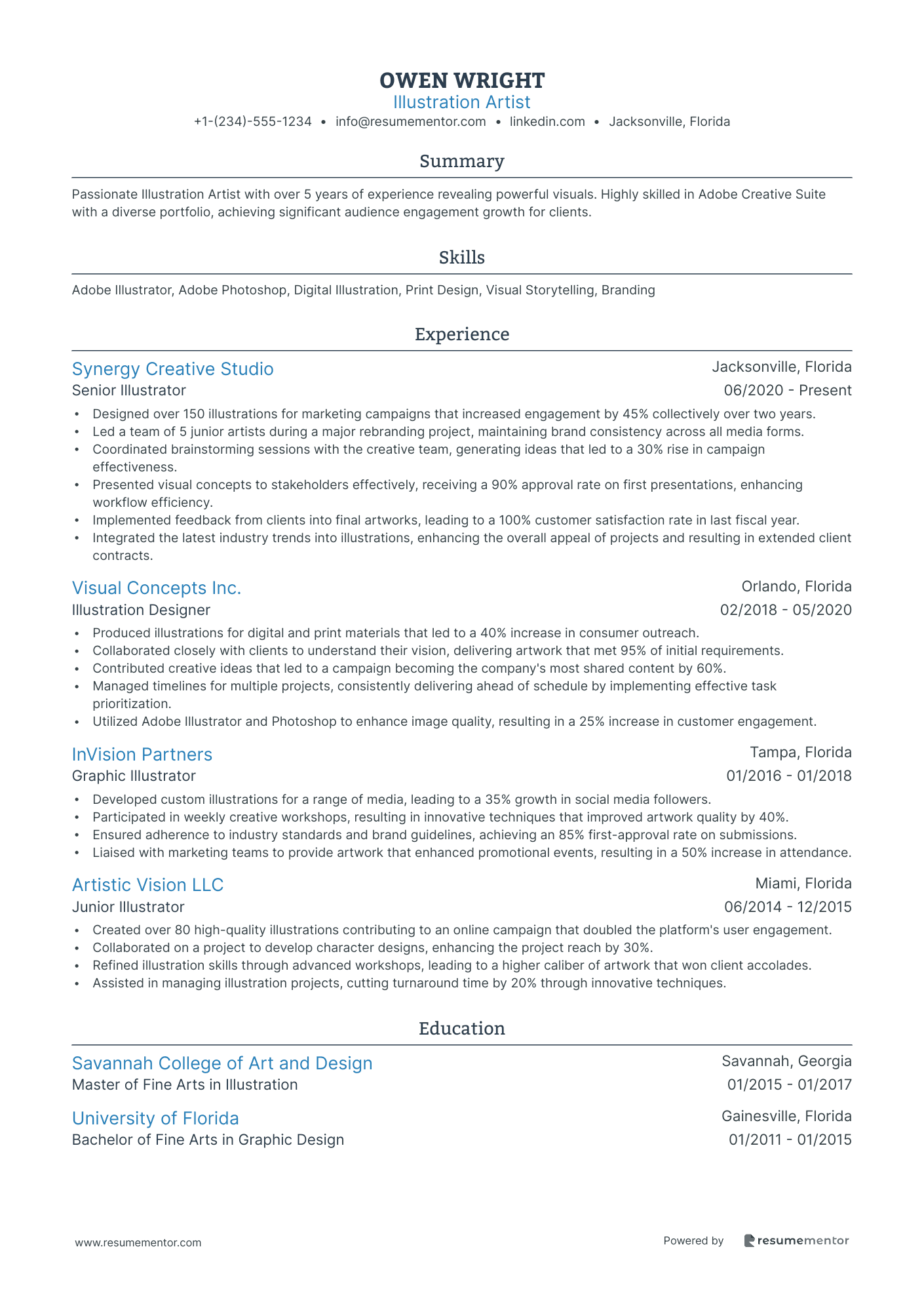
Illustration Artist
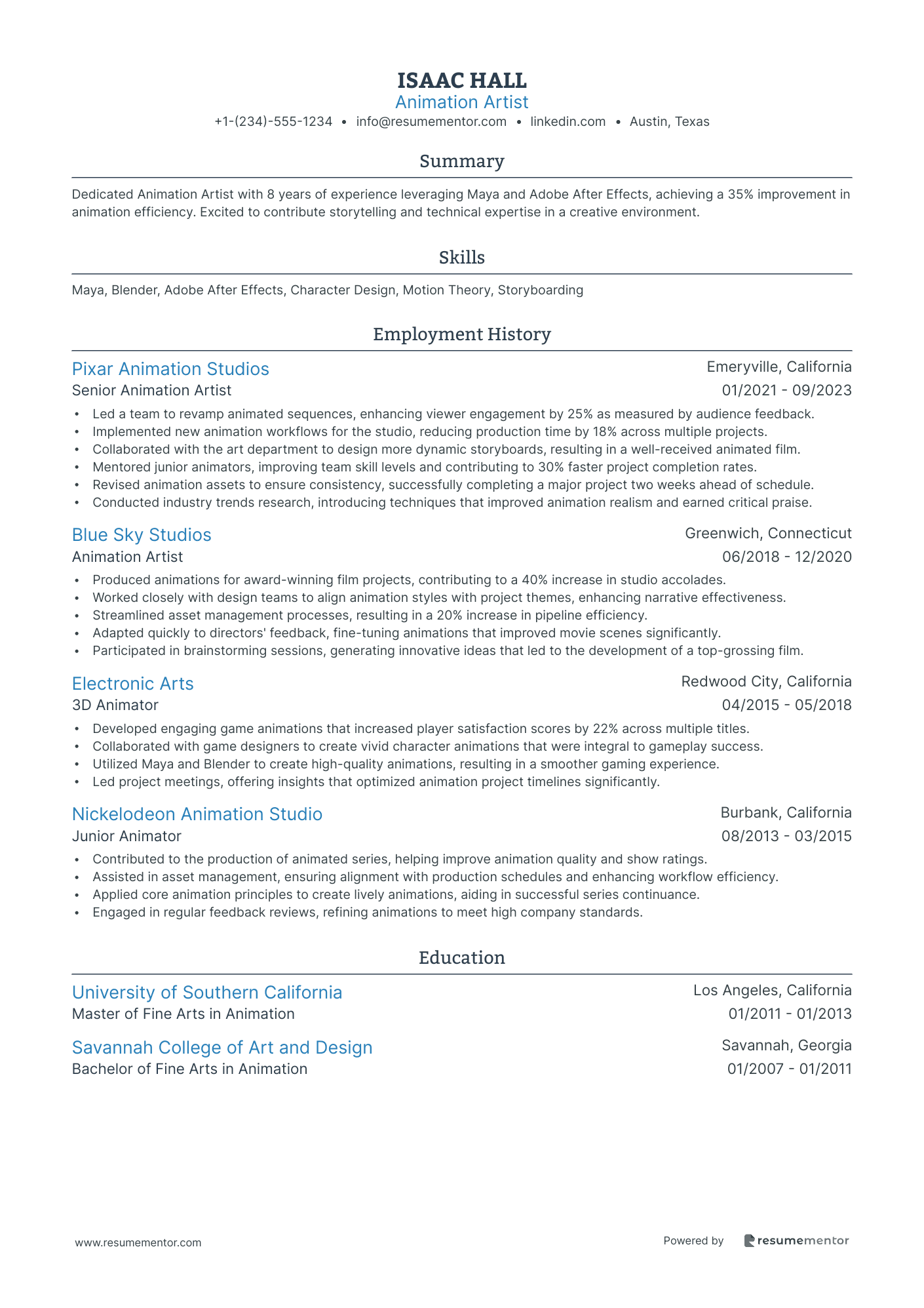
Animation Artist
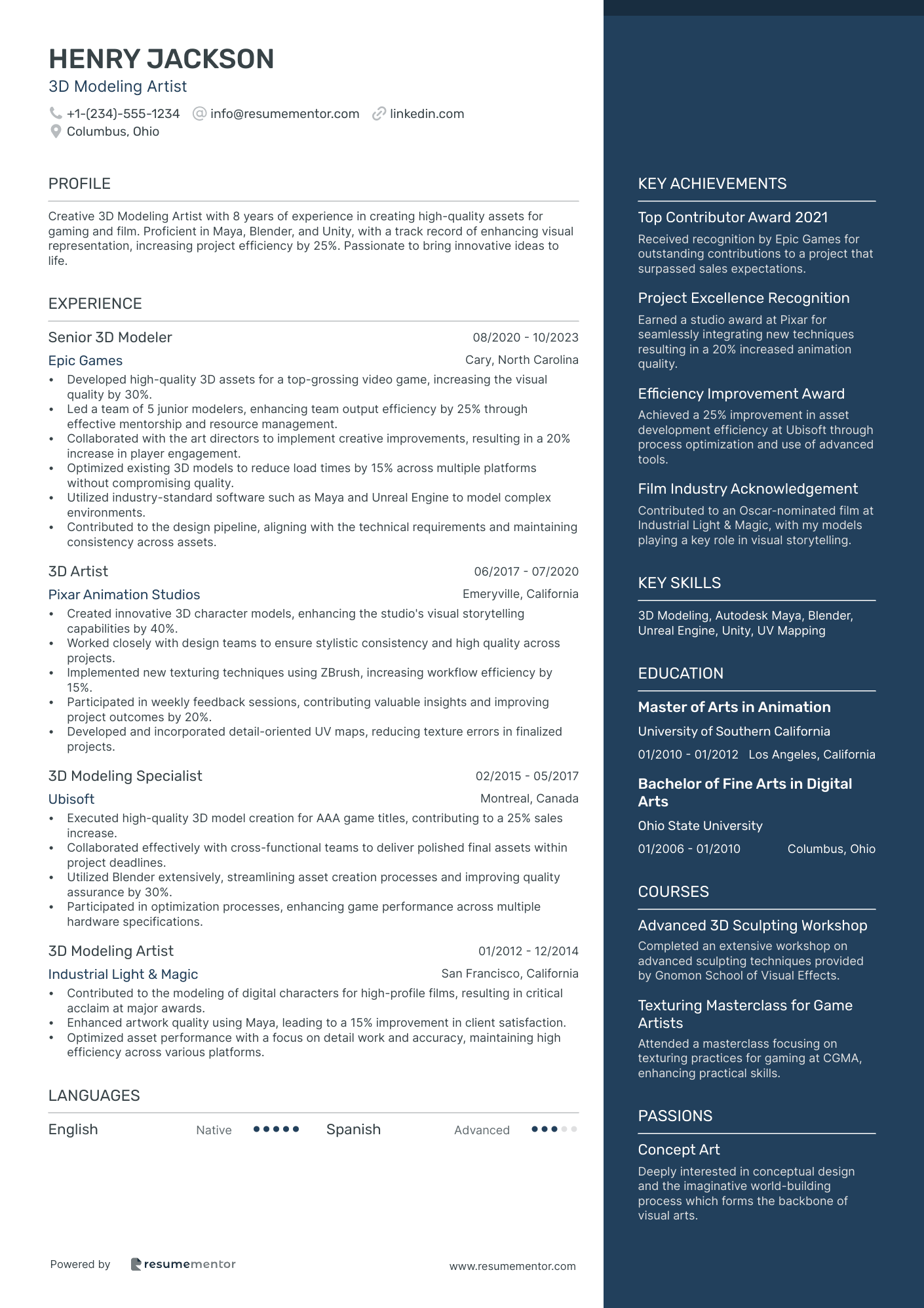
3D Modeling Artist
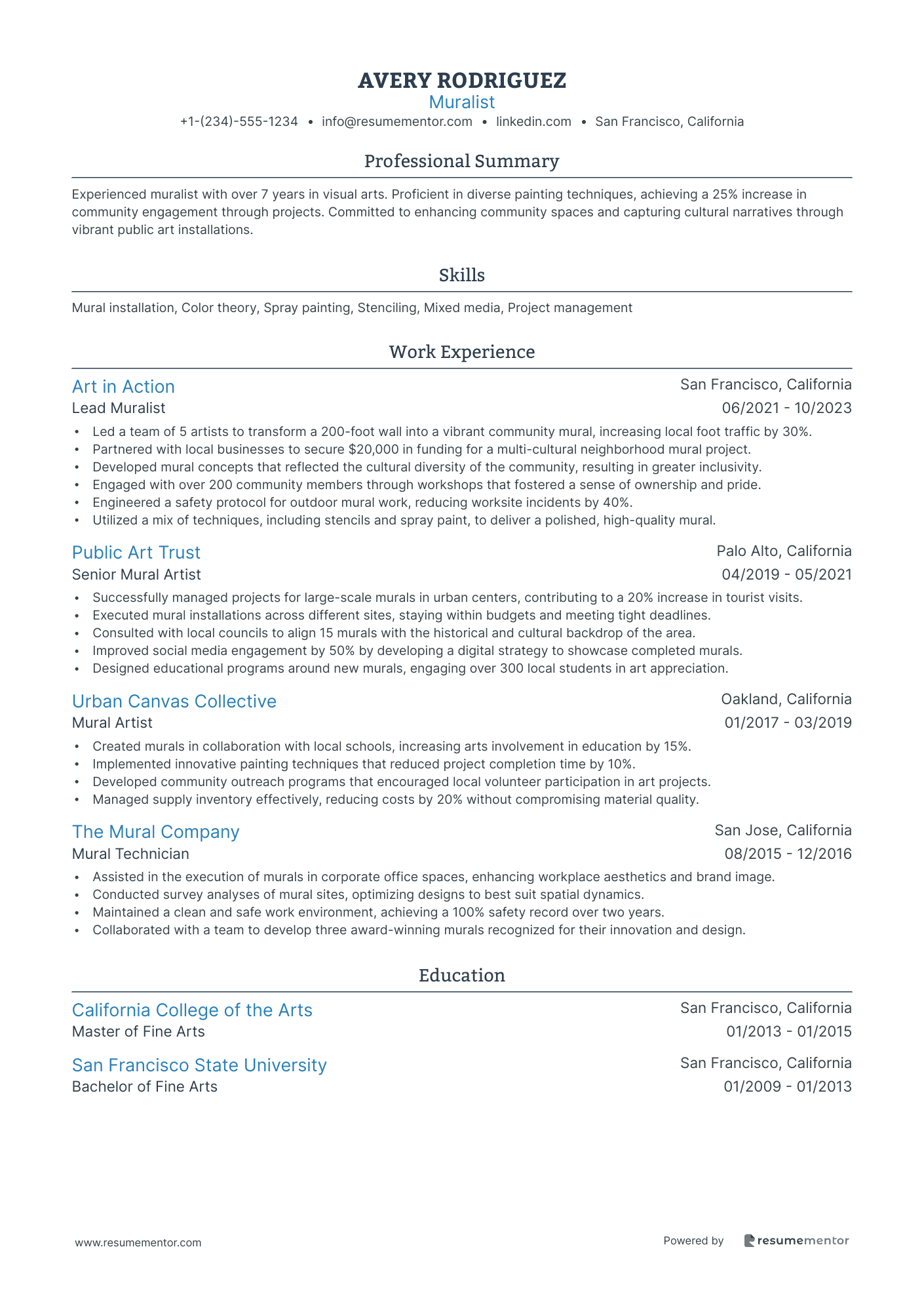
Muralist
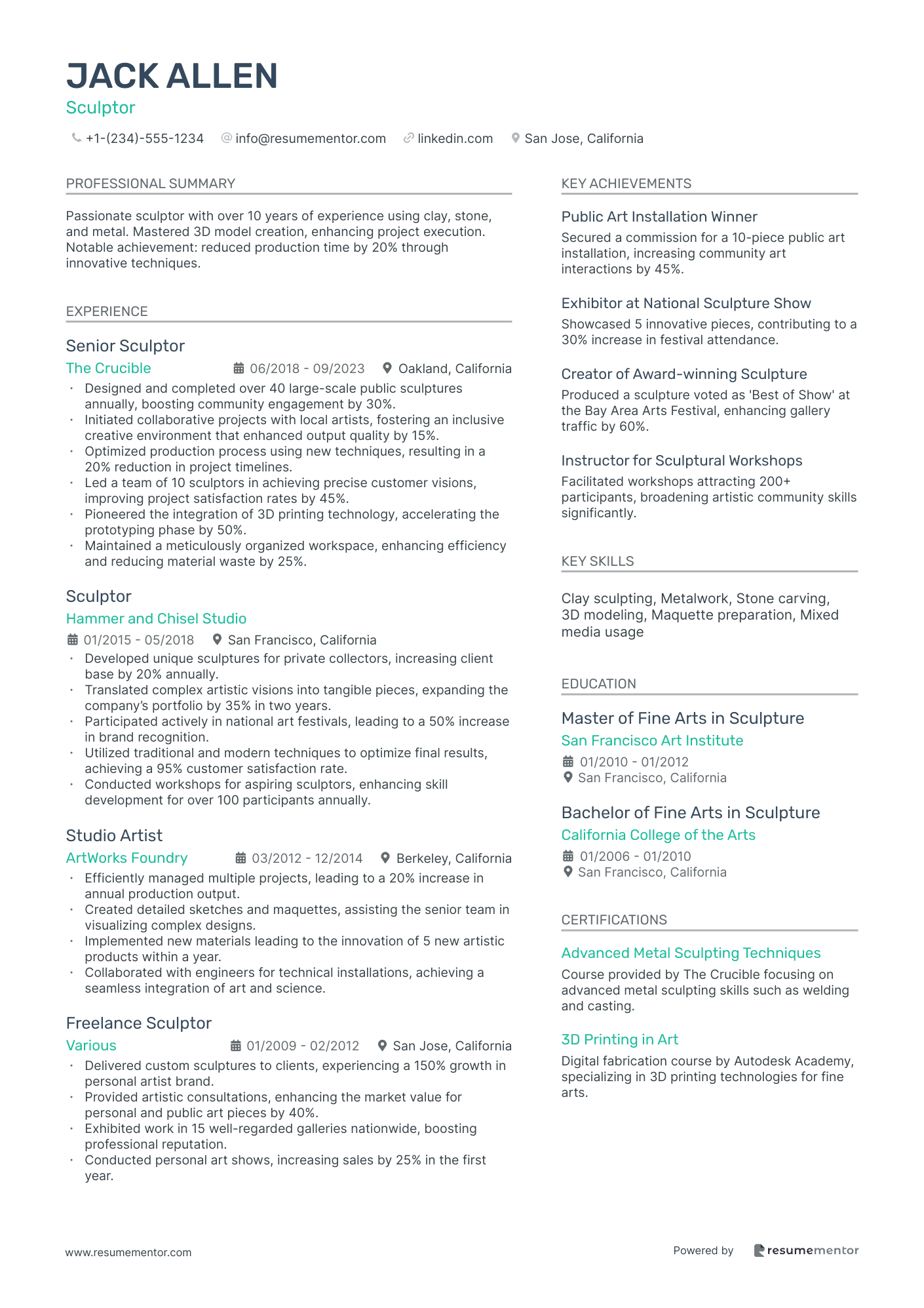
Sculptor
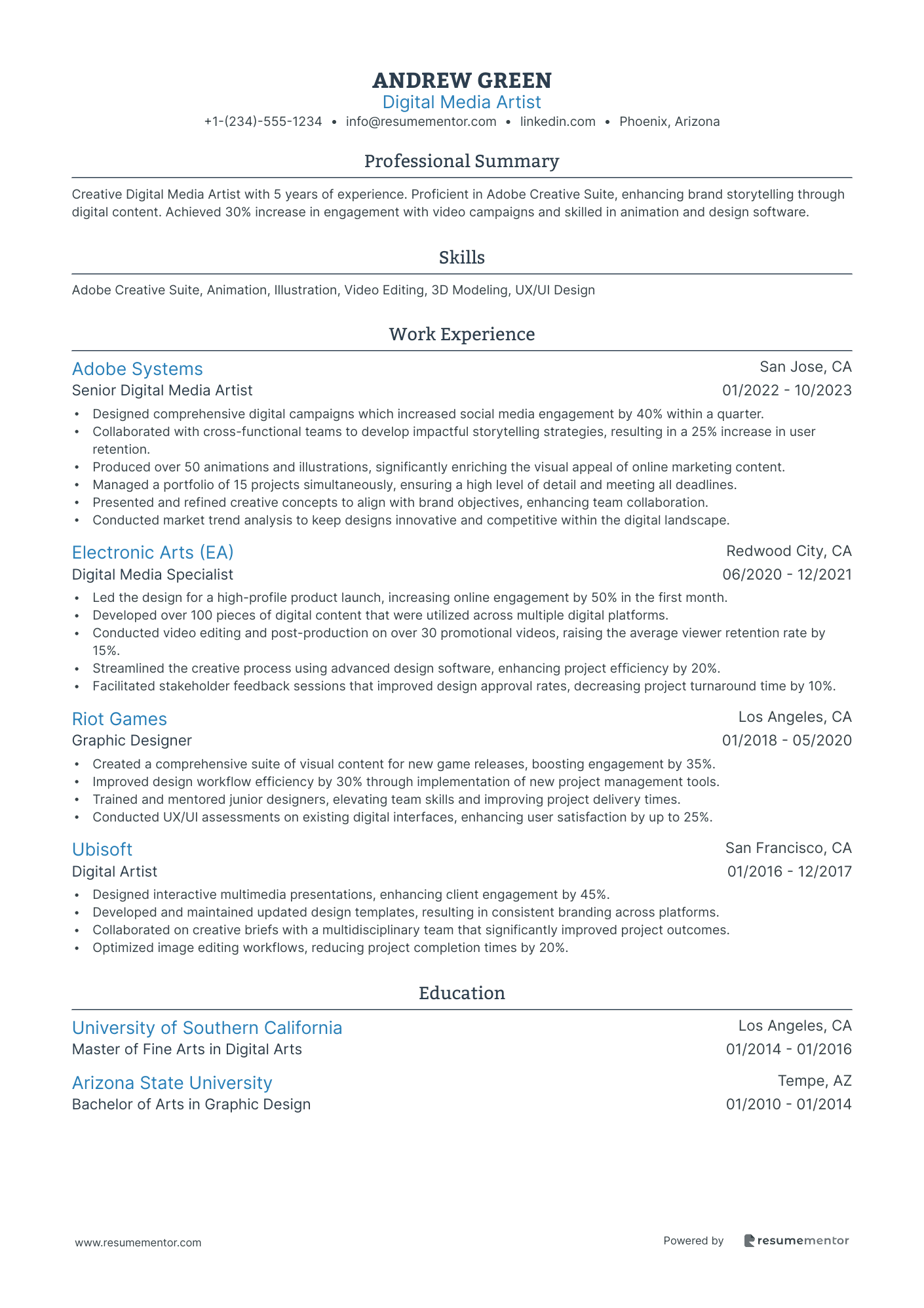
Digital Media Artist
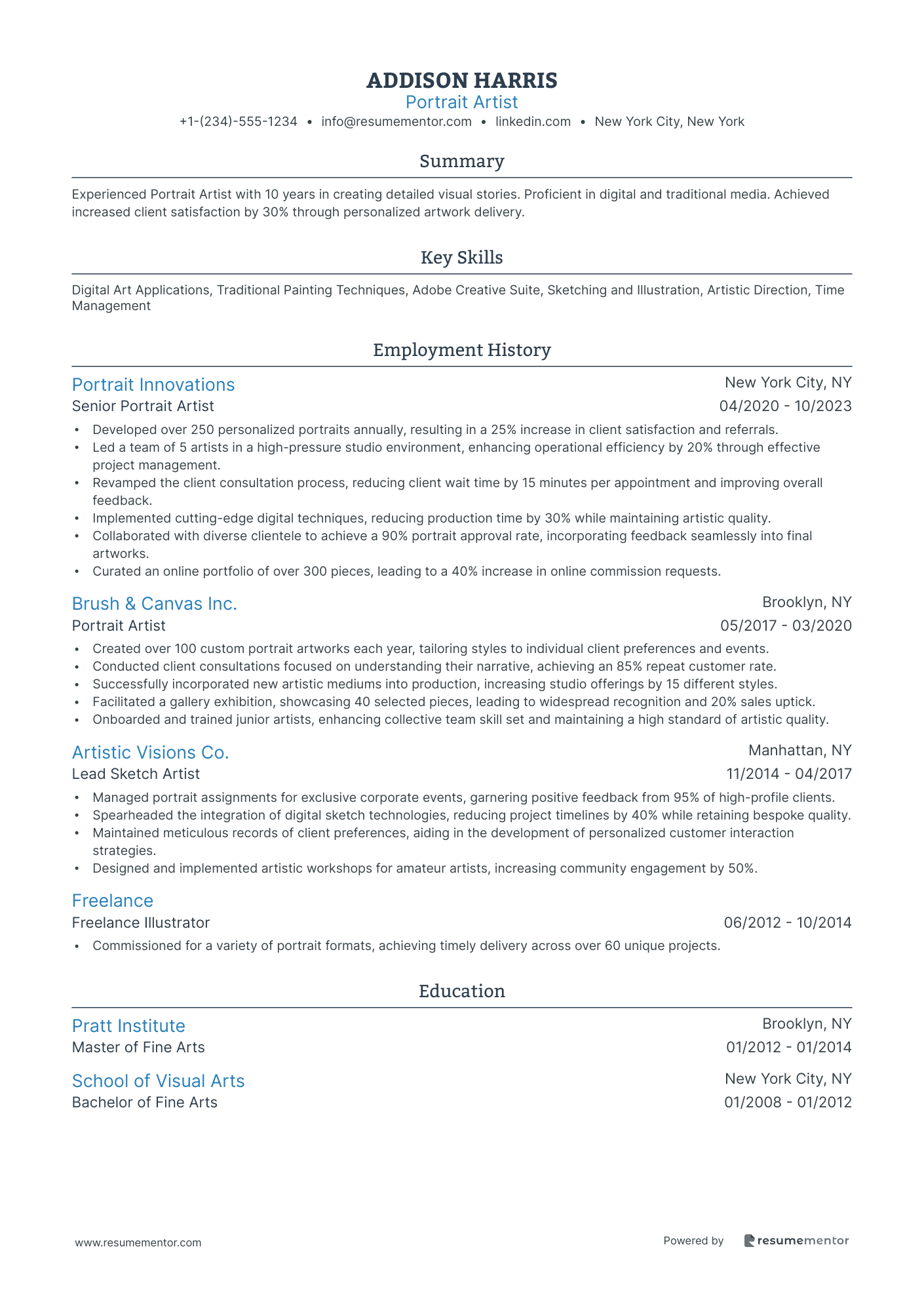
Portrait Artist
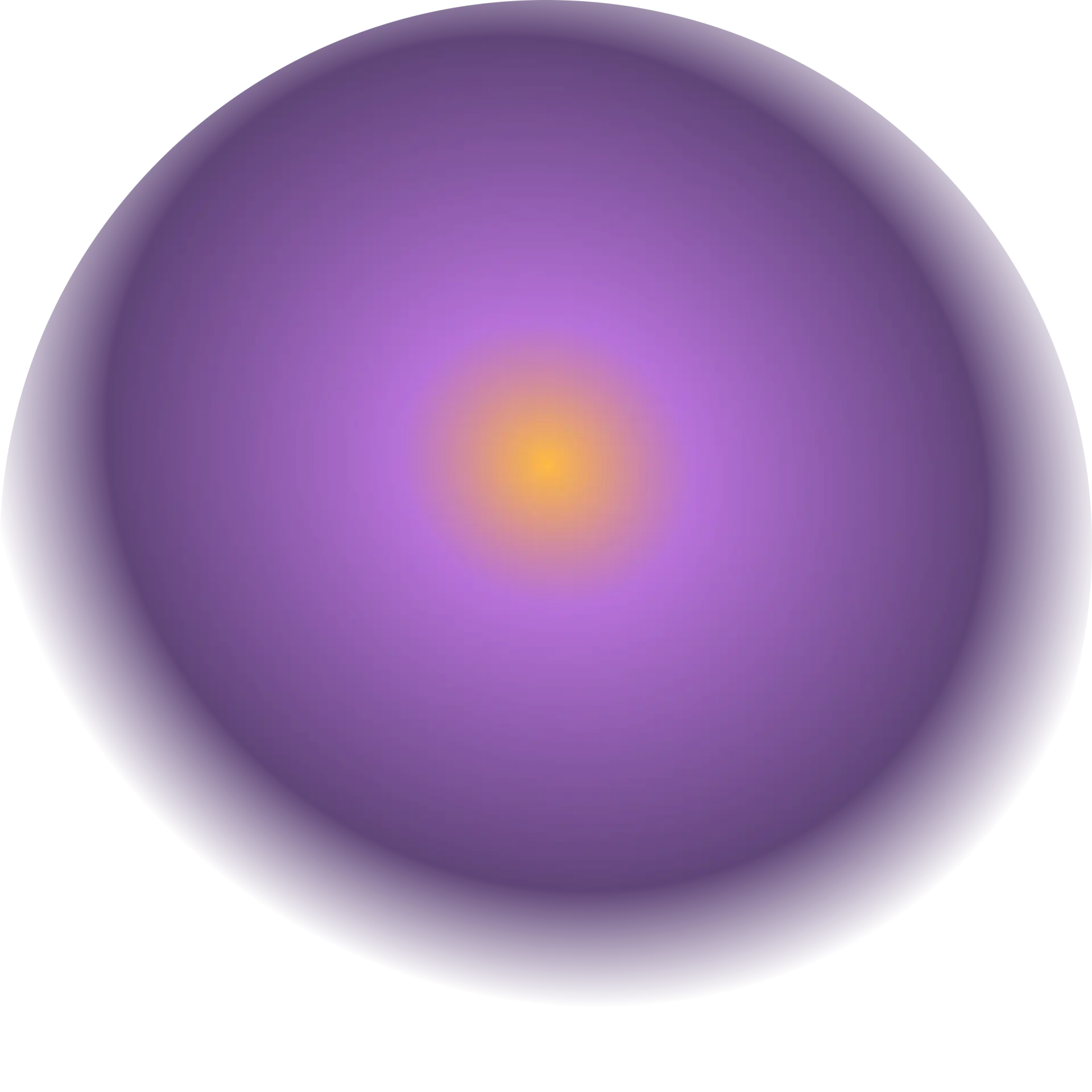
Conceptual Art Specialist resume sample
- •Developed and implemented over 50 original conceptual projects, leading to a 30% increase in consumer engagement.
- •Collaborated with marketing teams to create visual narratives that resulted in a 20% sales increase over two quarters.
- •Mentored a team of 5 junior artists, guiding them in conceptual visualization, resulting in a 15% improvement in team output.
- •Executed digital illustrations that aligned with brand strategy, increasing brand recognition by 40% within a year.
- •Standardized the creation of mood boards and style guides, enhancing the consistency and quality of over 8 key projects.
- •Pioneered the integration of emerging technology into design processes, reducing project turnaround time by 25%.
- •Conceived and executed visual concepts for an award-winning campaign, increasing social media engagement by 50%.
- •Led cross-functional team collaborations, resulting in visual products that led to a 10% market share growth.
- •Enhanced brand identity for key clients, integrating industry trends into narratives, leading to a 35% client satisfaction hike.
- •Presented concepts to stakeholders, incorporating feedback effectively and delivering projects well before deadlines.
- •Conducted in-depth research on target demographics to refine visual representations, improving audience resonance by 25%.
- •Created detailed illustrations for 20+ projects, significantly enhancing client deliverables and achieving 98% client satisfaction.
- •Transformed abstract ideas into visual designs, improving brand storytelling and increasing departmental revenue by 15%.
- •Contributed to the successful launch of 5 products through compelling visual supports, increasing product visibility by 30%.
- •Launched a visual art campaign that reached over 1 million media impressions within the first month.
- •Developed art pieces for prestigious client campaigns, enhancing brand images and achieving a clientele growth of 20%.
- •Executed cross-team collaborations that resulted in smooth project workflows and a 10% efficiency improvement.
- •Innovated in traditional and digital art mediums to revitalize branding efforts, leading to a 25% increase in project success.
- •Performed extensive audience analysis for client campaigns, aligning visual art with market needs, enriching consumer experiences.
Graphic Design Artist resume sample
- •Led a team to redesign the company’s branding strategy, which resulted in a 35% increase in brand recognition and customer engagement.
- •Designed and executed digital marketing campaigns across a variety of platforms, improving user interaction metrics by 22%.
- •Collaborated with diverse teams, delivering over 30 successful projects under tight deadlines while ensuring brand consistency.
- •Utilized advanced Photoshop techniques to enhance project visuals, contributing to a 40% increase in customer satisfaction.
- •Stayed ahead in the field by implementing five new design trends per quarter, fostering continual innovation in our strategies.
- •Prepared and delivered high-quality print designs for various clients, resulting in a 50% rise in repeat business.
- •Developed and maintained a cohesive design language for different brands, which led to a 30% boost in customer recall.
- •Created over 100 visually engaging social media graphics monthly, significantly increasing online engagement.
- •Worked with marketing teams to integrate design elements in strategic campaigns, achieving a 15% rise in conversions.
- •Introduced streamlined workflows that improved project turnaround times by 25%, enhancing team productivity.
- •Designed interactive web elements to improve user experience, resulting in a 10% reduction in bounce rate.
- •Conducted comprehensive market analysis to design graphics for campaigns, leading to a successful 5% increase in market share.
- •Translated complex client requirements into achievable design projects, enhancing client satisfaction rates by 12%.
- •Optimized graphics for a range of digital platforms, resulting in consistent brand visibility across channels.
- •Executed event branding designs that effectively boosted both attendee engagement and post-event feedback ratings.
- •Coordinated multiple design projects simultaneously, ensuring timely delivery and alignment with brand guidelines.
- •Developed graphic elements for animated film promotions, fostering a 10% increase in pre-release interest.
- •Managed a team of junior designers, resulting in a streamlined workflow and accelerated project delivery.
- •Created detailed visual proposals for prospective clients, improving bid success rates by 18%.
Fine Art Restoration Expert resume sample
- •Led the restoration of over 40 masterpieces annually, increasing the value and longevity of each piece by 30%.
- •Implemented new conservation techniques, resulting in a 25% reduction in restoration time for high-profile projects.
- •Managed a team of four specialists, ensuring adherence to conservation standards while maintaining efficient timelines.
- •Developed detailed condition reports, facilitating transparent communication with collectors and stakeholders.
- •Collaborated with top art curators to restore historically significant pieces, maintaining their cultural relevance.
- •Enhanced collaboration processes with galleries, leading to a 15% increase in project efficiency and satisfaction.
- •Conserved over 30 pieces, increasing audience engagement by presenting restored art with historical narratives.
- •Trained junior conservators in advanced art restoration techniques, enhancing team capabilities by 40%.
- •Performed complex restorations on mixed media art, ensuring all materials were properly stabilized and preserved.
- •Streamlined documentation processes, resulting in 20% faster report generation and client communication.
- •Collaborated with curators to identify suitable restoration approaches for newly acquired pieces.
- •Restored over 50 significant artworks, including sculptures, ensuring preservation of cultural significance.
- •Engaged with collectors to educate them on artwork care, resulting in better long-term maintenance of their collections.
- •Successfully managed complex restoration projects, meeting tight deadlines without compromising quality.
- •Utilized cutting-edge technology for art conservation, optimizing restoration techniques for diverse materials.
- •Assisted in the conservation of various media artworks, enhancing visitor engagement by preserving authenticity.
- •Supported the preparation and documentation of restoration processes, ensuring comprehensive project tracking.
- •Collaborated with curatorial staff to identify and prioritize conservation issues in the museum's collection.
- •Participated in educational workshops, promoting awareness of art conservation techniques to museum visitors.
Illustration Artist resume sample
- •Designed over 150 illustrations for marketing campaigns that increased engagement by 45% collectively over two years.
- •Led a team of 5 junior artists during a major rebranding project, maintaining brand consistency across all media forms.
- •Coordinated brainstorming sessions with the creative team, generating ideas that led to a 30% rise in campaign effectiveness.
- •Presented visual concepts to stakeholders effectively, receiving a 90% approval rate on first presentations, enhancing workflow efficiency.
- •Implemented feedback from clients into final artworks, leading to a 100% customer satisfaction rate in last fiscal year.
- •Integrated the latest industry trends into illustrations, enhancing the overall appeal of projects and resulting in extended client contracts.
- •Produced illustrations for digital and print materials that led to a 40% increase in consumer outreach.
- •Collaborated closely with clients to understand their vision, delivering artwork that met 95% of initial requirements.
- •Contributed creative ideas that led to a campaign becoming the company's most shared content by 60%.
- •Managed timelines for multiple projects, consistently delivering ahead of schedule by implementing effective task prioritization.
- •Utilized Adobe Illustrator and Photoshop to enhance image quality, resulting in a 25% increase in customer engagement.
- •Developed custom illustrations for a range of media, leading to a 35% growth in social media followers.
- •Participated in weekly creative workshops, resulting in innovative techniques that improved artwork quality by 40%.
- •Ensured adherence to industry standards and brand guidelines, achieving an 85% first-approval rate on submissions.
- •Liaised with marketing teams to provide artwork that enhanced promotional events, resulting in a 50% increase in attendance.
- •Created over 80 high-quality illustrations contributing to an online campaign that doubled the platform's user engagement.
- •Collaborated on a project to develop character designs, enhancing the project reach by 30%.
- •Refined illustration skills through advanced workshops, leading to a higher caliber of artwork that won client accolades.
- •Assisted in managing illustration projects, cutting turnaround time by 20% through innovative techniques.
Animation Artist resume sample
- •Led a team to revamp animated sequences, enhancing viewer engagement by 25% as measured by audience feedback.
- •Implemented new animation workflows for the studio, reducing production time by 18% across multiple projects.
- •Collaborated with the art department to design more dynamic storyboards, resulting in a well-received animated film.
- •Mentored junior animators, improving team skill levels and contributing to 30% faster project completion rates.
- •Revised animation assets to ensure consistency, successfully completing a major project two weeks ahead of schedule.
- •Conducted industry trends research, introducing techniques that improved animation realism and earned critical praise.
- •Produced animations for award-winning film projects, contributing to a 40% increase in studio accolades.
- •Worked closely with design teams to align animation styles with project themes, enhancing narrative effectiveness.
- •Streamlined asset management processes, resulting in a 20% increase in pipeline efficiency.
- •Adapted quickly to directors' feedback, fine-tuning animations that improved movie scenes significantly.
- •Participated in brainstorming sessions, generating innovative ideas that led to the development of a top-grossing film.
- •Developed engaging game animations that increased player satisfaction scores by 22% across multiple titles.
- •Collaborated with game designers to create vivid character animations that were integral to gameplay success.
- •Utilized Maya and Blender to create high-quality animations, resulting in a smoother gaming experience.
- •Led project meetings, offering insights that optimized animation project timelines significantly.
- •Contributed to the production of animated series, helping improve animation quality and show ratings.
- •Assisted in asset management, ensuring alignment with production schedules and enhancing workflow efficiency.
- •Applied core animation principles to create lively animations, aiding in successful series continuance.
- •Engaged in regular feedback reviews, refining animations to meet high company standards.
3D Modeling Artist resume sample
- •Developed high-quality 3D assets for a top-grossing video game, increasing the visual quality by 30%.
- •Led a team of 5 junior modelers, enhancing team output efficiency by 25% through effective mentorship and resource management.
- •Collaborated with the art directors to implement creative improvements, resulting in a 20% increase in player engagement.
- •Optimized existing 3D models to reduce load times by 15% across multiple platforms without compromising quality.
- •Utilized industry-standard software such as Maya and Unreal Engine to model complex environments.
- •Contributed to the design pipeline, aligning with the technical requirements and maintaining consistency across assets.
- •Created innovative 3D character models, enhancing the studio's visual storytelling capabilities by 40%.
- •Worked closely with design teams to ensure stylistic consistency and high quality across projects.
- •Implemented new texturing techniques using ZBrush, increasing workflow efficiency by 15%.
- •Participated in weekly feedback sessions, contributing valuable insights and improving project outcomes by 20%.
- •Developed and incorporated detail-oriented UV maps, reducing texture errors in finalized projects.
- •Executed high-quality 3D model creation for AAA game titles, contributing to a 25% sales increase.
- •Collaborated effectively with cross-functional teams to deliver polished final assets within project deadlines.
- •Utilized Blender extensively, streamlining asset creation processes and improving quality assurance by 30%.
- •Participated in optimization processes, enhancing game performance across multiple hardware specifications.
- •Contributed to the modeling of digital characters for high-profile films, resulting in critical acclaim at major awards.
- •Enhanced artwork quality using Maya, leading to a 15% improvement in client satisfaction.
- •Optimized asset performance with a focus on detail work and accuracy, maintaining high efficiency across various platforms.
Muralist resume sample
- •Led a team of 5 artists to transform a 200-foot wall into a vibrant community mural, increasing local foot traffic by 30%.
- •Partnered with local businesses to secure $20,000 in funding for a multi-cultural neighborhood mural project.
- •Developed mural concepts that reflected the cultural diversity of the community, resulting in greater inclusivity.
- •Engaged with over 200 community members through workshops that fostered a sense of ownership and pride.
- •Engineered a safety protocol for outdoor mural work, reducing worksite incidents by 40%.
- •Utilized a mix of techniques, including stencils and spray paint, to deliver a polished, high-quality mural.
- •Successfully managed projects for large-scale murals in urban centers, contributing to a 20% increase in tourist visits.
- •Executed mural installations across different sites, staying within budgets and meeting tight deadlines.
- •Consulted with local councils to align 15 murals with the historical and cultural backdrop of the area.
- •Improved social media engagement by 50% by developing a digital strategy to showcase completed murals.
- •Designed educational programs around new murals, engaging over 300 local students in art appreciation.
- •Created murals in collaboration with local schools, increasing arts involvement in education by 15%.
- •Implemented innovative painting techniques that reduced project completion time by 10%.
- •Developed community outreach programs that encouraged local volunteer participation in art projects.
- •Managed supply inventory effectively, reducing costs by 20% without compromising material quality.
- •Assisted in the execution of murals in corporate office spaces, enhancing workplace aesthetics and brand image.
- •Conducted survey analyses of mural sites, optimizing designs to best suit spatial dynamics.
- •Maintained a clean and safe work environment, achieving a 100% safety record over two years.
- •Collaborated with a team to develop three award-winning murals recognized for their innovation and design.
Sculptor resume sample
- •Designed and completed over 40 large-scale public sculptures annually, boosting community engagement by 30%.
- •Initiated collaborative projects with local artists, fostering an inclusive creative environment that enhanced output quality by 15%.
- •Optimized production process using new techniques, resulting in a 20% reduction in project timelines.
- •Led a team of 10 sculptors in achieving precise customer visions, improving project satisfaction rates by 45%.
- •Pioneered the integration of 3D printing technology, accelerating the prototyping phase by 50%.
- •Maintained a meticulously organized workspace, enhancing efficiency and reducing material waste by 25%.
- •Developed unique sculptures for private collectors, increasing client base by 20% annually.
- •Translated complex artistic visions into tangible pieces, expanding the company’s portfolio by 35% in two years.
- •Participated actively in national art festivals, leading to a 50% increase in brand recognition.
- •Utilized traditional and modern techniques to optimize final results, achieving a 95% customer satisfaction rate.
- •Conducted workshops for aspiring sculptors, enhancing skill development for over 100 participants annually.
- •Efficiently managed multiple projects, leading to a 20% increase in annual production output.
- •Created detailed sketches and maquettes, assisting the senior team in visualizing complex designs.
- •Implemented new materials leading to the innovation of 5 new artistic products within a year.
- •Collaborated with engineers for technical installations, achieving a seamless integration of art and science.
- •Delivered custom sculptures to clients, experiencing a 150% growth in personal artist brand.
- •Provided artistic consultations, enhancing the market value for personal and public art pieces by 40%.
- •Exhibited work in 15 well-regarded galleries nationwide, boosting professional reputation.
- •Conducted personal art shows, increasing sales by 25% in the first year.
Digital Media Artist resume sample
- •Designed comprehensive digital campaigns which increased social media engagement by 40% within a quarter.
- •Collaborated with cross-functional teams to develop impactful storytelling strategies, resulting in a 25% increase in user retention.
- •Produced over 50 animations and illustrations, significantly enriching the visual appeal of online marketing content.
- •Managed a portfolio of 15 projects simultaneously, ensuring a high level of detail and meeting all deadlines.
- •Presented and refined creative concepts to align with brand objectives, enhancing team collaboration.
- •Conducted market trend analysis to keep designs innovative and competitive within the digital landscape.
- •Led the design for a high-profile product launch, increasing online engagement by 50% in the first month.
- •Developed over 100 pieces of digital content that were utilized across multiple digital platforms.
- •Conducted video editing and post-production on over 30 promotional videos, raising the average viewer retention rate by 15%.
- •Streamlined the creative process using advanced design software, enhancing project efficiency by 20%.
- •Facilitated stakeholder feedback sessions that improved design approval rates, decreasing project turnaround time by 10%.
- •Created a comprehensive suite of visual content for new game releases, boosting engagement by 35%.
- •Improved design workflow efficiency by 30% through implementation of new project management tools.
- •Trained and mentored junior designers, elevating team skills and improving project delivery times.
- •Conducted UX/UI assessments on existing digital interfaces, enhancing user satisfaction by up to 25%.
- •Designed interactive multimedia presentations, enhancing client engagement by 45%.
- •Developed and maintained updated design templates, resulting in consistent branding across platforms.
- •Collaborated on creative briefs with a multidisciplinary team that significantly improved project outcomes.
- •Optimized image editing workflows, reducing project completion times by 20%.
Portrait Artist resume sample
- •Developed over 250 personalized portraits annually, resulting in a 25% increase in client satisfaction and referrals.
- •Led a team of 5 artists in a high-pressure studio environment, enhancing operational efficiency by 20% through effective project management.
- •Revamped the client consultation process, reducing client wait time by 15 minutes per appointment and improving overall feedback.
- •Implemented cutting-edge digital techniques, reducing production time by 30% while maintaining artistic quality.
- •Collaborated with diverse clientele to achieve a 90% portrait approval rate, incorporating feedback seamlessly into final artworks.
- •Curated an online portfolio of over 300 pieces, leading to a 40% increase in online commission requests.
- •Created over 100 custom portrait artworks each year, tailoring styles to individual client preferences and events.
- •Conducted client consultations focused on understanding their narrative, achieving an 85% repeat customer rate.
- •Successfully incorporated new artistic mediums into production, increasing studio offerings by 15 different styles.
- •Facilitated a gallery exhibition, showcasing 40 selected pieces, leading to widespread recognition and 20% sales uptick.
- •Onboarded and trained junior artists, enhancing collective team skill set and maintaining a high standard of artistic quality.
- •Managed portrait assignments for exclusive corporate events, garnering positive feedback from 95% of high-profile clients.
- •Spearheaded the integration of digital sketch technologies, reducing project timelines by 40% while retaining bespoke quality.
- •Maintained meticulous records of client preferences, aiding in the development of personalized customer interaction strategies.
- •Designed and implemented artistic workshops for amateur artists, increasing community engagement by 50%.
- •Commissioned for a variety of portrait formats, achieving timely delivery across over 60 unique projects.
Crafting your resume as an artist can feel like painting with a limited palette. You possess a rich tapestry of creativity and skills, but expressing them on paper is often daunting. The traditional job market might not fully grasp the unique value you bring, which makes it challenging to convey your art in a way that resonates with employers' needs. To bridge this gap, it's crucial to present your artistic journey in a manner that aligns with what potential clients or employers are looking for.
A structured approach is your solution here. A well-crafted resume should not only showcase your technical prowess, like mastery in specific mediums or software, but also narrate your story through its design and layout. With so much to communicate, the format of your resume can easily make or break your job application. Utilizing a professional resume template provides you with a strong starting point, allowing your talents to shine clearly and professionally.
Think of your resume as more than just a list of jobs and skills. It’s a canvas where you strategically place your achievements and skills to form a compelling picture of who you are as an artist. By carefully curating what you include and how you present it, you can ensure your talents stand out and effectively communicate with those who might not yet speak the language of art.
Key Takeaways
- An artist's resume should reflect not only technical skills but also the creative journey and the unique value they offer to potential employers.
- The resume format should seamlessly highlight both artistic and technical skills using a combination format and clean, easy-to-read fonts like Rubik and Montserrat.
- Quantifying achievements and using strong action words in the experience section can effectively communicate an artist's impact and skills, aligning them with employer expectations.
- Highlighting relevant hard and soft skills, such as drawing, digital illustration, creativity, and adaptability, can enhance the appeal of an artist’s resume to potential employers.
- Additional sections like certifications, languages, hobbies, and volunteer work can provide a comprehensive view of the artist's skills and personality, adding depth to the resume.
What to focus on when writing your artist resume
An artist resume should convey your creative expertise and unique style to the recruiter, ensuring they see your true artistic potential. By highlighting your technical skills, notable achievements, and relevant experiences, you can leave a lasting impression.
How to structure your artist resume
- Contact Information: Start with your name, phone number, email address, and a link to your online portfolio or personal website. This crucial information allows recruiters to easily reach you and view your work firsthand. Make sure your contact details are current and professional— a personalized email or a custom website URL can add a touch of your artistic brand.
- Professional Summary: Offer a snapshot of your artistic vision, specialties, and key accomplishments. This section should be concise but powerful, giving the recruiter a strong first impression of who you are as an artist. Describing your years in the industry and mentioning significant projects or collaborations can immediately demonstrate your impact—consider tailoring this summary to reflect the specific role you're applying for.
- Work Experience: When detailing your past roles, include job titles, company names, locations, and dates. Use this section to narrate your professional journey, focusing on positions in galleries, museums, or studios that have shaped your career. Highlight projects that showcase both your creativity and your collaborative skills, illustrating how your past experiences align with the role you're pursuing.
- Education: Your educational background is equally important—list your degrees, the institutions you attended, and graduation dates, emphasizing any specialized training or notable art school experiences that distinguish you from others. Mention any notable instructors or mentors who have influenced your style, as this personal touch can add depth to your resume.
- Skills: A strong skills section can further support your candidacy. Include relevant artistic techniques like painting or sculpture, along with technical skills such as digital design or art software proficiency. Tailor this list to match the job description, ensuring you highlight skills that are most relevant to the position.
- Exhibitions and Awards: Showcasing your participation in gallery shows, exhibitions, or awards can highlight your talent and the recognition you've received within the art community. Underscore your influence in the art world by mentioning prestigious awards or well-known exhibits that have featured your work, illustrating your impact and reputation.
To strategically format each section and explore them in more depth, we’ll cover them below, focusing on crafting a cohesive and compelling artist resume.
Which resume format to choose
Creating the perfect artist resume begins with choosing the right format. For artists, a combination format is ideal because it seamlessly highlights both your technical skills and creative experiences. This format helps if you have a variety of artistic projects and roles, allowing you to showcase what makes you unique. The right fonts also play an important role in crafting your resume. Opting for modern and clean fonts like Rubik, Montserrat, and Raleway can subtly convey your sense of style and professionalism. These fonts are visually appealing yet easy to read, ensuring that your work history and achievements stand out. When it comes to file types, always use PDFs for your resume. PDFs lock in your layout, ensuring that your carefully crafted design remains consistent across different devices and platforms, which is crucial for maintaining professionalism. Margins, though often overlooked, are essential in creating a tidy and approachable document. Setting them to about one inch on all sides gives your content room to breathe, guiding the reader's eye naturally through your narrative. With these elements aligned, your artist resume will not only reflect your artistic journey but also make a memorable impact on potential employers.
How to write a quantifiable resume experience section
To make your artist resume's experience section truly shine, focus on what employers value: your specific achievements and the impact you've made. Start with your most recent roles, organizing them in reverse chronological order to maintain relevancy over the past 10-15 years. Highlight job titles that emphasize leadership or specialized skills pertinent to your field. This way, your experience section speaks directly to the job ad by offering details that align with the role. Using strong action words like "created," "designed," or "exhibited" helps convey your influence effectively. By quantifying your achievements, you paint a clear picture of the tangible results you've delivered.
- •Developed over 50 branding projects, boosting client satisfaction by 30%.
- •Led a team to design a campaign, increasing online engagement by 40%.
- •Implemented new design software, enhancing productivity by 20%.
- •Exhibited personal artwork in 5 local galleries, enhancing community presence.
This experience section effectively showcases your professional journey by aligning achievements with employer expectations. Quantifying outcomes like a 30% boost in client satisfaction makes your contributions concrete, which speaks directly to any potential employer. Aligning your skills with job ads ensures you meet the specific qualifications they seek. Action words like "developed" and "led" add energy to your narrative. Organizing the entries with precise details like dates and locations provides a clear and engaging story of your growth and impact in the field.
Training and Development Focused resume experience section
A Training and Development-focused artist's resume experience section should emphasize your role in educational activities, workshops, and mentoring within the arts. Start by articulating the context of each position, detailing how you contributed to training and educational initiatives. Highlight your involvement in crafting and refining curricula, workshops, or training programs, and mention any accolades or positive feedback you received. It's crucial to illustrate the impact of your efforts, such as noticeable skill improvements, higher engagement levels, or transformative changes in the learning environment.
Ensure your experience stands out with clear, concise bullet points, including dates, job titles, and the organizations' names. Demonstrate your ability to inspire and guide others in their artistic growth. Where possible, use metrics and specific achievements to underscore the effectiveness of your training efforts, offering concrete evidence of your successes. This approach will not only showcase your dedication to nurturing talent but also highlight your commitment to fostering growth within the arts community.
Art Educator
Creative Arts Center
2018 - 2022
- Led art workshops for over 200 participants, focusing on skill development and creativity.
- Designed and implemented curriculum enhancements that increased workshop engagement by 30%.
- Mentored aspiring artists, resulting in 10 students showcasing their work in local galleries.
- Collaborated with fellow artists to organize annual art fairs and exhibitions.
Leadership-Focused resume experience section
A leadership-focused artist resume experience section should spotlight your ability to guide creative projects and teams toward success. Start by reflecting on moments when you took charge, made pivotal decisions, and led teams to achieve remarkable artistic outcomes. Illustrate how your leadership inspired your colleagues and elevated the project's quality. Ensure that you choose examples demonstrating your skills in managing teams and coordinating projects effectively, offering a glimpse into your strengths in leadership roles.
In the bullet points, aim to showcase specific achievements and their impact on the projects you led. Use statistics and examples to provide a clear picture of your leadership influence. Illustrate your readiness to take on significant responsibilities and make key decisions that drive success. This is your chance to highlight your leadership journey, showing how you can inspire and direct creative teams toward achieving their artistic goals.
Head Curator
Creative Visions Gallery
June 2021 - Present
- Led a team of 10 artists in creating a traveling art exhibit viewed by over 10,000 visitors.
- Developed a collaborative workflow that improved project efficiency by 30%.
- Negotiated with five major galleries to showcase the exhibit, expanding geographical reach.
- Organized monthly feedback sessions that boosted team morale and creativity.
Technology-Focused resume experience section
A technology-focused artist resume experience section should seamlessly integrate your creative prowess with your tech skills. Start by choosing experiences that illustrate how you've used technology to enhance your artistic endeavors. Clearly describe specific projects where tech tools have elevated your art, allowing you to achieve remarkable results. As you lay out your role, the technology used, and the project's impact, your unique blend of skills will shine through.
Zero in on experiences where technological and artistic skills meet harmoniously. Outline what you achieved, the tools you leveraged, and your contributions to the projects, using bullet points for clarity. By providing concrete examples, you show hiring managers exactly how your skills meet their needs, giving them a vivid picture of your tech-savvy artistry.
Digital Artist
TechArt Studio
June 2021 - Present
- Created a 3D virtual art gallery using VR technology, increasing engagement by 30%.
- Developed interactive digital installations for a public art exhibit using projection mapping.
- Collaborated with a software engineering team to design an app for augmented reality art experiences.
- Managed a digital portfolio showcasing interactive and multimedia art, enhancing online visibility by 50%.
Skills-Focused resume experience section
A skills-focused artist resume experience section should emphasize your creativity and achievements. Begin with your job title, employment dates, and where you worked. Rather than listing daily tasks, highlight specific projects, techniques, and tools you've used, weaving in the impact or results of your work whenever possible. This approach not only showcases your talents but also highlights how your efforts contributed to success.
It's important to use simple, direct language that clearly demonstrates your artistic skills as a valuable asset. Avoid jargon and complex phrases, ensuring that each bullet point is concise yet descriptive. This format helps potential employers or collaborators quickly grasp your capabilities, reinforcing your profile as a talented artist.
Freelance Digital Artist
Jan 2020 - Dec 2022
- Created over 100 digital illustrations for a diverse range of clients, enhancing brand visuals.
- Utilized Adobe Creative Suite to design compelling graphics that increased social media engagement by 30%.
- Collaborated with a team of artists to produce artwork for a successful gallery exhibit.
- Received frequent client praise for innovative use of color and design.
Write your artist resume summary section
A skills-focused artist resume summary can truly set you apart in your field. If you have substantial experience, crafting an engaging summary should be your priority, as it provides a dynamic overview of your talents and accomplishments. Think of this part of your resume as your artistic elevator pitch, something that quickly captures attention and tells your story. You’ll want to spotlight your major achievements, significant awards, and unique skills succinctly. Take this as an example:
In this summary, potential employers immediately see a snapshot of your career, focusing on your creative drive and notable successes like award wins. When crafting this section, it’s essential to understand the nuances between a resume summary and other components like an objective, profile, or summary of qualifications. A resume summary is a concise look at your career, spotlighting your top skills and achievements. In contrast, a resume objective outlines your career aspirations and what you aim to accomplish, making it ideal for artists with less experience. Meanwhile, a resume profile combines these aspects, offering a fuller picture of your skills, experiences, and goals. Lastly, a summary of qualifications succinctly lists your most relevant skills and notable achievements, especially tailored for roles that require specific expertise. Understanding these differences helps you present your experience in the most effective light.
Listing your artist skills on your resume
A skill-focused artist resume should highlight what sets you apart. Start by showcasing your skills as a standalone section or seamlessly integrate them into other areas such as your experience and summary. Your strengths and soft skills are the personal traits that enhance teamwork and leadership, while hard skills represent the specific talents or knowledge you've mastered over time. By using your skills and strengths as keywords, you increase your chances of capturing the attention of potential employers.
This standalone skills section effectively highlights essential skills in the art field by emphasizing a variety of talents that show both range and depth. The skills listed are easy for employers to recognize and align well with what they are seeking.
Best hard skills to feature on your artist resume
Your hard skills should exhibit technical proficiency and the ability to work with diverse media. This will showcase your skills with specialized tools and software that lead to tangible creative results.
Hard Skills
- Drawing
- Digital Illustration
- Sculpting
- Painting
- Graphic Design
- 3D Modeling
- Animation
- Photography
- Video Editing
- Printmaking
- Art Restoration
- Textile Design
- Concept Art
- Ceramic Art
- Calligraphy
Best soft skills to feature on your artist resume
Soft skills reveal how you engage with others and bring your artistic ideas to life. These skills signal your ability to effectively interact with clients, fellow artists, and audiences.
Soft Skills
- Creativity
- Communication
- Problem-Solving
- Time Management
- Adaptability
- Collaboration
- Attention to Detail
- Critical Thinking
- Self-Motivation
- Patience
- Open-Mindedness
- Empathy
- Decision-Making
- Resourcefulness
- Strategic Thinking
How to include your education on your resume
Your education section is an important part of your artist resume, highlighting your academic achievements and relevant qualifications. Tailoring this section to match the position you are applying for is crucial. It helps prospective employers understand your background and how it aligns with their needs. Exclude any education that does not show how you are fit for the job.
Including your GPA is optional, but if it's impressive, you can add it. List it next to your degree, specifying both your GPA and the highest possible GPA, like "3.8/4.0". Honors like cum laude should follow your degree name, showcasing your academic excellence. Whenever listing a degree, clearly include the degree type, institution, and graduation date.
Below are examples to clarify:
The second example is strong because it clearly outlines a relevant degree in Fine Arts with excellent academic performance. Including the Magna Cum Laude distinction highlights a high level of achievement that aligns with artistic dedication and skill. The education timeline is realistic and appropriate, and the GPA mentioned reinforces the applicant's competency and dedication.
How to include artist certificates on your resume
Including a certificates section is crucial for any artist's resume. It highlights your additional qualifications and provides evidence of your expertise. List the name of the certificate clearly so it stands out. Include the date you received it to show its relevance. Add the issuing organization to lend credibility. Certificates can enhance the header of your resume as well, making it instantly appealing. For example, "Certified Art Instructor, Rhode Island School of Design, 2022."
Incorporating certificates thoughtfully can set you apart. Consider this format to ensure everything is clear and easy to read. The certificate's name, followed by the issuer, allows employers to verify your achievements quickly. Ensure certificates are directly related to the artist position you are applying for.
The example works well by listing relevant artistic certifications. "Digital Painting Mastery" from a known art school shows depth. Simultaneously, "Advanced Graphic Design" demonstrates broad skills essential for diverse art projects. These certificates add to your qualifications in an easy-to-read format.
Extra sections to include on your artist resume
Creating a well-rounded artist resume requires including sections that highlight your skills, experiences, and unique qualities. This helps to present a comprehensive view of who you are both professionally and personally.
Language section — Highlight your language skills to show your ability to connect with diverse audiences. Knowing multiple languages can open up opportunities for international projects and collaborations.
Hobbies and interests section — Share your hobbies and interests to give insight into your creative passions beyond your professional work. This section helps potential employers understand your personality and what inspires your artistic journey.
Volunteer work section — Demonstrate your community involvement by detailing your volunteer efforts. Volunteering can also reveal leadership and collaboration skills, adding depth to your resume.
Books section — List influential books to show your commitment to continuous learning and personal growth. This section can also display your interest in staying updated with industry trends or artistic techniques.
In Conclusion
In conclusion, creating an artist resume that captures your skills and achievements without overwhelming the reader can be a delicate balance, but with the right approach, it is certainly achievable. By structuring your resume into clear and concise sections, you lay a strong foundation for effective communication with potential employers. Present your contact details clearly, and don't forget to include links to digital portfolios where your work can be accessed easily. Your professional summary should be a snapshot of your artistic vision and accomplishments, making a lasting first impression. Include significant work experiences with quantifiable achievements, offering tangible evidence of your impact in previous roles. Educational qualifications and any relevant certifications should align closely with the job you seek, emphasizing your preparedness and capability. Highlighting a combination of technical skills and soft skills ensures employers understand the full range of your abilities, as both are crucial in the creative field. Consider adding extra sections, such as languages or volunteer work, to showcase your breadth of experience and interests. Remember, your resume is not just a document; it’s a curated art piece itself, reflecting your journey and potential as an artist. By tailoring every element of it, you stand out and tell your unique story eloquently.
Related Articles
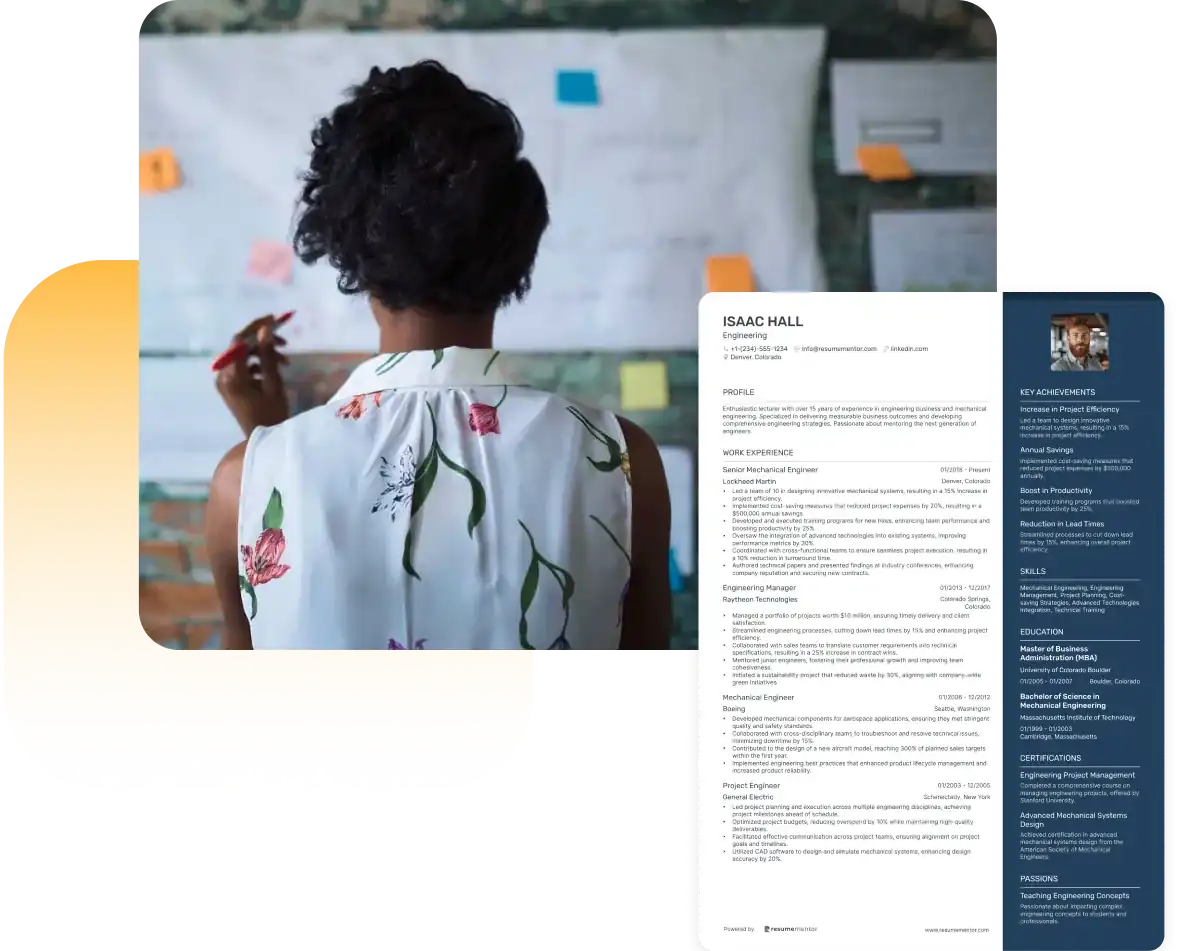
Continue Reading
Check more recommended readings to get the job of your dreams.
Resume
Resources
Tools
© 2025. All rights reserved.
Made with love by people who care.

